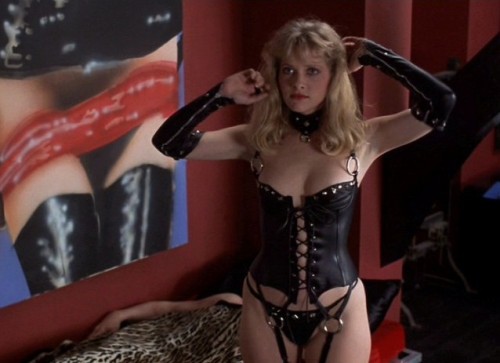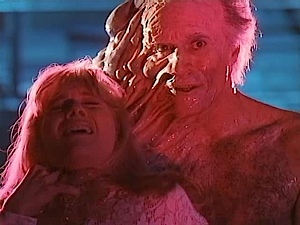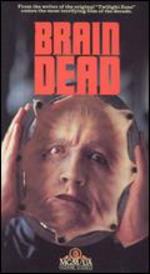Stuart Gordon appreciation week continues:
Following up the horror/comedy classic Re-Animator (1985) was no easy task, but director Stuart Gordon and company managed to not only match that film in its zany outlandishness, but to top it in excessive goriness and magnificent special effects work in the mostly underseen and overlooked From Beyond (1986).
Another adaptation of a H.P. Lovecraft short story, this tale of madness follows Crawford Tillinghast (Jeffrey Combs) and his mentor Dr. Edward Pretorius (Ted Sorel) as they conduct a secretive science experiment, the kind that is inherently doomed to go wrong. They have invented a device called "the resonator" that allows those within close range to see beyond what they can normally perceive, essentially activating a sixth sense, when the machine is in operation. Opening these doorways of perception, however, works both ways, as they see strange and vicious creatures floating in the air around them, creatures that can see (and attack) them. Crawford wants to turn off the machine, but Pretorius insists that it stay on, that he wants to "see more than any man has seen." Soon after, Pretorius is left headless on the floor and Crawford is running from the attic laboratory and out of the house.
Taken to a mental institution, Crawford is accused of murder and diagnosed with schizophrenia by the cold Dr. Bloch (Carolyn Purdy-Gordon). When Dr. Katherine McMichaels (Barbara Crampton) shows up to follow up on Crawford's case, she runs a CT-scan on him and finds that his pineal gland is 3x the size it should be (a side effect of the resonator). Released into the custody of Dr. McMichaels, along with her police escort Bubba Brownlee (Ken Foree), the three of them return to Pretorius' house to re-create the experiment, something Crawford is understandably reluctant to do. He agrees, knowing that it is his only chance at clearing his name and avoid spending the rest of his life in a mental institute.
Of course, recreating the experiments has repercussions, namely the return of Dr. Pretorius who has gone through some. . .changes (and continues to do so). What follows involves slimy tentacle-monsters, toothy worm-beasts, a bug storm, a little S&M sex, eyeball sucking, brain eating, explosions, and other general craziness. It's hard to talk about From Beyond without giving away some of the more modest surprises, so if you like seeing a movie fresh and spoiler-free, stop reading here. If you need further convincing, or if perchance you've seen the film, continue on.
Dr. Pretorius has many monstrous forms, going through five different changes throughout the film, each more grotesque than the last. In general, he's a slimy, pink mass of flesh and muscle, mixed with teeth and tentacles. Also, he more or less resembles a penis, due to the extended neck that his head and face protrude from, not to mention all the slithery tentacles waggling around. This phallic imagery can also be found in Crawford's (eventual) bald head and extended pineal gland. This (sort of) subtle imagery seems to reinforce the stronger sexual themes that are present in the film, as the character's sexual desires are opened up as a result of using the resonator (they explain this by saying the pineal gland is connected to such things; it isn't). Katherine and Crawford start to develop a connection, while Pretorius wants to make a connection with Katherine, to "open her mind up," as his sadistic sexual tendencies seem furthered since transforming.
The special effects were accomplished by a team (as they usually are) of professionals, including John Naulin, Mark Shostrom, and John Carl Buechler. Naulin was principal special effects artist on Re-Animator, and he designed the basement worm-monster that terrorizes Crawford and Bubba, which sort of resembles the monsters in The Deadly Spawn (1982). Buechler did work on Re-Animator designing the zombies featured in the finale. On From Beyond he was responsible for creature designs and the various incarnations of transformation that Pretorius goes through, supervising the mechanics needed to pull off such complicated effects. It's fantastic effects work, probably the best visualization of a Lovecraftian nightmare put to film. The transformations remind me of John Carpenter's The Thing (1982, effects by Rob Bottin) and, to a lesser degree, Brian Yuzna's Society (1989, effects by Screaming Mad George), although that one might have more to do with the color palette of the movie and the sliminess of the creatures.
The dominate color scheme of the film is pink, purple, and blue, all with a sickly neon hue. As mentioned, the monsters are fleshy and slimy, and these candy colors gives it this slightly cartoony, EC Comic style look. It enhances the otherworldliness of the violence, the horror, and the terrifyingly unreal monsters. I find the film to be less goofy than Re-Animator, although there is definitely humor present (Bubba hams it up especially). The humor is suitably black and maybe a bit dry, as seen in scenes where a little dog licks at the stump of a headless corpse, or later when you see the chalk outline of said body (sans head).
After the success of Re-Animator, director Stuart Gordon signed a three picture deal with Empire Pictures and producer Charles Band, a wise decision on Band's part, as Gordon is easily the best director to ever work for the company. Gordon would relocate to Rome, Italy, where Empire had their studios located, and he would use some of the same crew and cast from his debut film, but most of the production was rounded out with Italian crewmembers. Returning was screenplay writer Dennis Paoli, producer Brian Yuzna, cinematographer Mac Ahlberg, editor Lee Percy, composer Richard Band, and others. Both Jeffrey Combs and Barbara Crampton would return, this time both playing very different characters than the last go round.
Gordon was interested in doing a series of Lovecraft films, similar to Roger Corman's Edgar Allan Poe films. This idea wouldn't quite take off, but Gordon would return to the concept with Combs and Crampton for Castle Freak (1995) and would also adapt Lovecraft with 2001's Dagon (a film originally intended to be his Re-Animator follow-up) and his Masters of Horror entry Dreams of the Witch-House from 2005.
Jeffery Combs plays an altogether different kind of weird scientist in this film. As Herbert West, Combs was brash and bold, but as Crawford his intenseness is compounded by his troubled meekness. Combs can somehow credibly and believably deliver a line of dialogue like "He bit off his head. . .like. . .a gingerbread man!" Crawford eventually becomes incredibly unhinged and acts erratically after his pineal gland emerges from his forehead. Despite becoming a murderous, eye-sucking monster, Crawford still retains a bits of humanity, displaying remorse and a bit of self-loathing. His final confrontation with Pretorius is equally horrific and outrageous in its execution. Other than his films with Stuart Gordon, Jeffrey Combs can be seen in The Frighteners (1996), House on Haunted Hill (1999), The Attic Expeditions (2001), and the new horror flick, Would You Rather (2012).
Compared to Megan in Re-Animator, Barbara Crampton has a much more substantial role as Dr. McMichaels. As I mentioned above, she has a good character arc, with clear motivations. She ignores the obvious danger potential of the resonator, becoming fixated on the idea that it could be used to diagnose and treat schizophrenia patients, an obsession of hers due to her father (a schizo) who died in a mental hospital. I love how Katherine, in great horror movie tradition, is left broken and crazed at films end. I can't say I've seen all of Crampton's work (such as her reoccurring roles on soap operas Young & the Restless and Bold and the Beautiful) but I think it might be safe to say that this is her finest performance.
Ted Sorel is a pretty great villain, giving Pretorius a threatening grandiosity. In the tradition of great villains, he thinks of himself as a supreme being, as the pinnacle of existence. His ego is only matched by his monstrous tendencies, such as in one of the more audacious scenes in the film, where Pretorius grabs Katherine and proceeds to molest her with his just-grown tentacle fingers (ewww). Sorel would have small roles in Lenny (1974) and Network (1976) before settling into a career mainly consisting of television guest-star work. Along with Barbara Crampton, From Beyond is, without a doubt, his career highlight.
Ken Foree is a genre favorite, his most legendary role being that of iconic badass Peter in Dawn of the Dead (1979). As policeman (and former football player) Bubba, Foree plays it loose and jovial, displaying bravery and showing true character. He also wears some of the littlest red shorts ever to be seen in a motion picture, in full display during the battle with the basement monster.
From Beyond doesn't have quite the reputation or cult following that Re-Animator has, which is a shame, as it is every bit as entertaining as its predecessor and maybe more daring in its depiction of Lovecraftian nightmare visuals. It definitely outdoes Re-Animator in terms of sheer whatthefuckery. If you're a fan of Lovecraft, practical special effects, gooey monsters, and/or weird scientific terrors, then you owe it to yourself to check out From Beyond, guaranteed to deliver on all fronts and on the promise that "humans are such easy prey."
*This trailer for From Beyond features a lot of the cool special effects and other crazy shit, but is also fairly heavy on SPOILERS, so proceed with caution:
Commerce section:
From Beyond was just released this week on a new Blu-ray/DVD combo pack from the fantastic folks over at Scream Factory (subsidiary of Shout! Factory). Packed full of special features, including commentaries, interviews, and more(!), the transfer looks great, the colors really pop, and you can see every dripping glob of goo. I noticed the detail during the bug storm scene was remarkable; you could really see those little buggers. If you're into it, you should totally buy yourself a copy. I know I will be.
Random thought:
Being a child of the 80s, I used to cruise up and down the aisles of the video store, looking at vivid box art in the horror section and just imagining what kind of stuff was in these movies, and the From Beyond VHS cover was so lurid and in-your-face that it definitely stood out to me. For some reason though, when I was younger I used to associate the title of From Beyond with Brain Dead (1989) and (to a lesser extent) Altered States (1980), simply because I thought they all had similar box covers (at least at the time):
I guess this style of VHS box can be called the "close-up of a weirdo's face" style of box art. I like it.











No comments:
Post a Comment